manchurian operations club
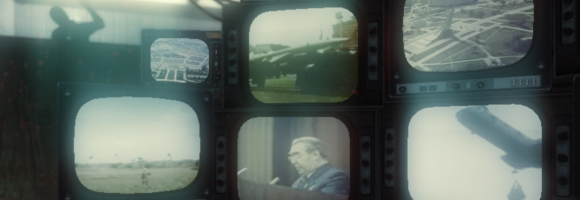
After having sent the manuscript of my book ‘↑Cyberanthropology‘ (Knorr 2011) to the editor, I went downtown in order to reward myself a bit. Perfectly aware that I’d never have time for it all, I nevertheless bought ‘↑Call of Duty: Black Ops‘ (Treyarch 2010), ‘Portal 2’ (Valve Corporation 2011), ‘↑Crysis 2‘ (Crytek 2011), and ‘↑Far Cry 2‘ (Ubisoft Montreal 2008). In a street café I treated myself with a latte macchiato, all the while wondering at the boxes of my newly acquired treasures. The collector’s edition of ‘Far Cry 2’ indeed comes in a treasure chest, containing e.g. a t-shirt.
Then I headed home, donned the Far-Cry-2 t-shirt, granted myself two days plus the night between them, and played through the single-player campaign of ‘Black Ops.’ The graphics are gorgeous, no doubt about it. At least on my machine they live up to what I have seen in the trailers.
But the storytelling is linear, resembles a movie—an interactive one, granted. The universal remedy to all kinds of problematic situations is +forward +shoot.
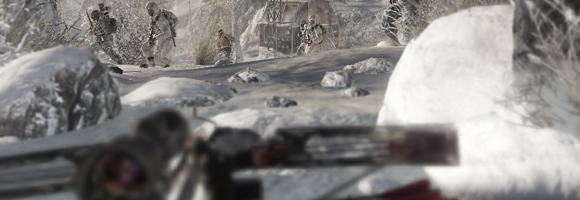
When I reached above pictured situation, my heart jumped in excitement. The scene I had seen in a trailer, and ingame it’s exactly as in the trailer. Disappointment followed immediately. The winter forest, somewhere inside the Soviet Union, is gorgeous, but can’t be explored. If you try to wander astray, you’ll bump into invisible walls, delineating the boundaries of the map. ‘Black Ops’ is the exact opposite of a freeroaming, sandbox game. I had no choice but following my team comrades until we reached the rapelling point, also to be seen in the trailer:

Before I realized how carefully you have to go down the ropes, I fell to death several times. Might be entirely my fault, because I never before played a title of the ‘↑Call of Duty‘ franchise, and simply am not accustomed to its peculiarities of moving around.
Be that as it may, despite the linearity, and despite my problems with the controls here and now, I got sucked into the game ever more. What I really dug is that it chases you through every conceivable cold-war theatre—even those which have turned hot. Here’s Vietnam (with a cameo appearance by Bruce Willis?):
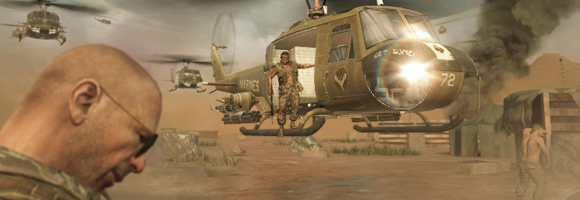
When I got deeper and deeper into the story, I liked the settings, the scenes, and the whole story more and more. It comprises aspects and elements of a whole array of my favourites: John Frankenheimer’s ‘↑The Manchurian Candidate‘ (1962) featuring Frank Sinatra, later ↑remade by Jonathan Demme (2004) featuring Denzel Washington. ‘↑12 Monkeys‘ (Gilliam 1995) featuring Bruce Willis, and in turn based on Chris Marker’s experimental short film ‘↵La jetée‘ (1962). And then of course ‘↑Fight Club‘ (Palahniuk 1996), faithfully ↑adapted to the silver screen by David Fincher (1999), starring Brad Pitt and Edward Norton.
To say, that ‘Black Ops’ is cyberpunk would be saying too much. But vast parts of its sujets, settings, ambience, æsthetics, narrative content, and narrative strategies are subject to the discourse cyberpunk.
Time travel is a core element of ’12 Monkeys’ and ‘La Jetée,’ but does not occur in ‘Black Ops.’ Only indirectly, if you will, as the whole story is told in flashbacks. But then again there are some blunt anachronisms concerning the weapons. For example, most striking, the Heckler & Koch G11 is available ingame. Although development of said weapon already began in 1968, and first prototypes were around in late 1971, the version in ‘Black Ops,’ the G11 K2 to my eye, wasn’t available before ca. 1990—again prototypes of it, as the G11 never saw mass-production.
Nevertheless the ambience is set by all kinds of cold-war icons appearing:
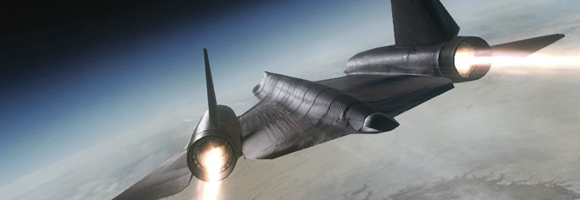
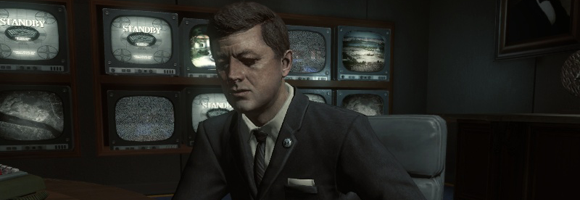

Yes, you get to fly the SR-71 ‘Blackbird,’ and, yes, you get to talk to Kennedy. And, yes, your very first objective in the story, relived in a flashback, is the assassination of Castro—↑Cuba didn’t like it.
I don’t know, if Kennedy wanted Castro assassinated—I don’t even know for sure who assassinated Kennedy.
Speaking of high-calibre assassinations and commando operations targeting international political figures—those haven’t vanished with the cold war, and not only are elements of fictitious cold-war alternate histories.
New-York based developer ↑Kuma Reality Games maintains the free tactical military first- and third-person shooter ↑Kuma\War. Almost on a monthly basis ↑new episodes can be downloaded and played. The latest is ↑Mission 108—Fall of Sirte: Gaddafi’s Last Stand. That already explains the game’s tag line: ‘Real war news. Real war games.’ Two other immensely popular missions or episodes are ↑Mission 62—Operation Red Dawn (capturing Saddam Hussein) and ↑Mission 107—The Death of Osama Bin Laden (self explanatory). If you play the latter and then compare it to the ↑meticulous write-up of the ongoings at Wikipedia, you’ll be astounded by the amount of research Kuma Reality Games does. For illustration, here is a screencap of ↑Osama Bin Laden’s compound in Abbottabad, Pakistan as depicted in Mission 107:

And here are the targets of missions 62 and 107:


The visual material seems to teach us that sporting a big beard is counterproductive in terms of lifetime.
So, watch out ↑Bryan Alexander, ↑Eugene Burger, and ↵Alan Moore …
But then again, Castro’s still around, JFK ain’t.

